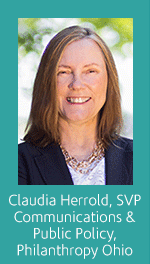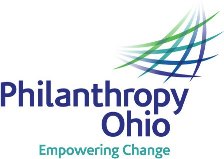Philanthropy Ohio comments on proposed regulations
March 5, 2018 at 5:12 pm Philanthropy Ohio Leave a comment

On Monday, Philanthropy Ohio submitted the following comments in response to Notice 2017-73 that addresses the use of donor advised funds (DAFs), on behalf of our 48 community foundation members.
Philanthropy Ohio is a statewide membership association serving private and community foundations, corporate giving programs, government agencies, United Ways and other public charity grantmakers as well as individual philanthropists. Our mission is to be the leading voice and premier resource for philanthropy across the state, particularly serving our over 220 members who collectively awarded more than $4 billion in grants last year. We provide the network, tools and knowledge to help people engaged in philanthropy become more effective, powerful changes agents in their communities.
Community foundations are a vital part of Ohio’s philanthropic landscape; we have the second highest number of any state (67 active, stand-alone foundations) and are third in giving ($515 million in 2015). As you might expect, donor advised funds are important, growing vehicles for our community foundations. About two-thirds of Ohio’s community foundations have DAFS, including small foundations serving rural communities as well as the largest grantmakers serving major cities. Recently completed research demonstrates the popularity and power of DAFs in our community foundations: the 10 largest community foundations have 3,345 DAFs that collectively hold $1.1 billion in assets and granted $184.5 million, representing an average payout of 11.6 percent (source: 2015/16 990s).

We see first-hand the impact that these foundations have in their communities, bringing local social and financial capital to address critical problems. These charitable endowments provide countless opportunities and numerous vehicles (including DAFs) for new and seasoned philanthropists to give back to their communities and make smart decisions about their charitable giving.
For many years, Philanthropy Ohio has advocated for policies that: encourage charitable giving; give donors the widest possible choice of vehicles for giving; and simplify the processes related to giving, at both the state and federal levels. Given the recently passed federal tax reform bill and its potential impact on charitable giving, we believe it is more important than ever that federal rules, regulations and tax laws make charitable giving easier rather than more complex and harder. It is from these values and vantage point that we offer comments related to the operations of DAFs as outlined in the Notice. We believe that minus evidence of widespread abuse related to any of the proposed topics addressed in the Notice that any guidance should have as its goal making the use and operation of DAFs easier and less complex for both donors and sponsoring organizations.
Section 3: Certain distributions from a DAF providing a more than incidental benefit to a donor, donor advisor or related person
We believe that the rules that apply to charitable deductions allowed for individual taxpayers should be mirrored in those for DAFs. An individual taxpayer may claim a charitable deduction for the portion of an event ticket or sponsorship for which no value or benefit is received, based upon the charity’s estimate of the value of those benefits. Current law and regulations do not prohibit such bifurcation and community foundation practice varies on this topic as some continue to bifurcate in such situations. Community foundation staff have and demonstrate the requisite skills and knowledge to accurately implement bifurcation, indeed helping donors comply at a higher rate, we suspect, than do individual taxpayers making similar charitable contributions. Further, there is nothing that states a legislative intent that DAFs and individuals by treated differently. For these reasons, Philanthropy Ohio requests the IRS and Treasury Department to reconsider the proposed guidance and accept the regulations and laws already in place that allow bifurcation.
Section 4: Certain distributions from a DAF permitted without regard to a charitable pledge made by a donor, donor advisor or related person

We appreciate the IRS proposal that distributions from a DAF to a charity that fulfill a pledge would not result in a more than incidental benefit to the donor/advisor but are troubled by the provision that makes it such only if the sponsoring organization makes no reference to the existence of the pledge when distributing the gift to the charity. We believe that this “don’t reveal” safe harbor for such distributions runs counter to our values – and those of our members – around transparency and accountability as we urge the adoption of best practices and credentialing. We also share our concern about the administrative burden the proposal places on charities that are charged with determining the legal enforceability of a pledge; we see that our community foundations’ practice is mixed and confused in the current environment and doubt that charities would be better equipped to make such determinations. For these reasons, Philanthropy Ohio asks the IRS and Treasury Department to adopt a regulation that explicitly permits the pledge of a donor/advisor to be paid from a DAF without further language about enforceability or lack of reference to the pledge during distribution.
Section 5: Preventing attempts to use a DAF to avoid public support limitations
We are not aware of instances where DAFs are being used to avoid public support limitations and believe that the proposed regulations would impose burdensome administrative requirements that far exceed the perceived problem. DAFs are public charities and grants from them should continue to be treated as public support, without any required attribution or aggregation and without any erosion of their public charity status. There is a perception perhaps on the part of the IRS that donors/advisors improperly control DAFs, a perception that is not supported by the practices and policies community foundations put in place to govern the operation of the funds and the foundation. Philanthropy Ohio opposes the proposed regulations and hopes that any regulations, if adopted, would provide relief from administrative burdens of sponsoring organizations and grantees.
Section 6: How private foundations use DAFs in support of their purposes

Our research into this area surfaced only a handful of examples of private foundations using DAFs at community foundations. In these cases, the private foundations used the funds to achieve a number of purposes related to their mission and, in most cases, the sponsoring organization imposed either formal policies or informal practices about required distributions, with disbursements occurring as early as 3 months from the date of the contribution. About one-third of Ohio’s community foundations comply with National Standards for Community Foundations, which include requiring adoption of best practice policies to address inactive DAFs, and many more are actively seeking such compliance. While we understand IRS concern about the potential for private foundations to use DAFs to avoid payout requirements and retain control over funds, this does not appear to be supported by the evidence. Philanthropy Ohio opposes any new regulations that would exclude DAF contributions from a private foundation’s qualifying distributions and suggest any new regulation be carefully crafted to stop any bad practice without limiting DAF use for genuine charitable purpose.
Claudia Y.W. Herrold
Entry filed under: Ohio Issues. Tags: charitable deduction, charitable giving, community foundation, DAF, donor advised fund, donors, foundation, IRS, Philanthropy, Philanthropy Ohio.

Trackback this post | Subscribe to the comments via RSS Feed